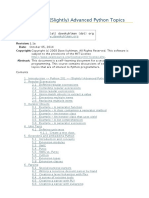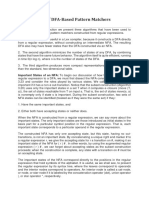0 ratings0% found this document useful (0 votes)
61 views9 Python Regex Group Functions
The document discusses Python regex group functions including the group() method to retrieve matched groups by name and the groupdict() method to return a dictionary of matched groups. It provides an example of using named groups and printing the matches, as well as an example of using groupdict() to return a dictionary of matches.
Uploaded by
ArvindSharmaCopyright
© © All Rights Reserved
We take content rights seriously. If you suspect this is your content, claim it here.
Available Formats
Download as PDF, TXT or read online on Scribd
0 ratings0% found this document useful (0 votes)
61 views9 Python Regex Group Functions
The document discusses Python regex group functions including the group() method to retrieve matched groups by name and the groupdict() method to return a dictionary of matched groups. It provides an example of using named groups and printing the matches, as well as an example of using groupdict() to return a dictionary of matches.
Uploaded by
ArvindSharmaCopyright
© © All Rights Reserved
We take content rights seriously. If you suspect this is your content, claim it here.
Available Formats
Download as PDF, TXT or read online on Scribd
You are on page 1/ 2
Python regex `group` functions
Python Regex group() function explained with examples: named groups and groupdict.
WE'LL COVER THE FOLLOWING
• Group dictionary Groupdict
A regular expression can have named groups. This makes it easier to retrieve
those groups after calling match() . But it makes the pattern more complex.
Following example shows a named group ( first and last ).
#!/usr/bin/python
import re
# A string.
name = "Learn Scientific"
# Match with named groups.
m = re.match("(?P<first>\w+)\W+(?P<last>\w+)", name)
# Print groups using names as id.
if m:
print(m.group("first"))
print(m.group("last"))
We can get the first name with the string “first” and the group() method. We
use “last” for the last name.
Group dictionary Groupdict #
A regular expression with named groups can fill a dictionary. This is done
with the groupdict() method. In the dictionary, each group name is a key and
Each value is the data matched by the regular expression. So we receive a key-
value store based on groups.
import re
name = "Scientific Python"
# Match names.
m = re.match("(?P<first>\w+)\W+(?P<last>\w+)", name)
if m:
# Get dict.
d = m.groupdict()
# Loop over dictionary with for-loop.
for t in d:
print(" key:", t)
print("value:", d[t])
You might also like
- Python Regular Expressions Quick ReferenceNo ratings yetPython Regular Expressions Quick Reference2 pages
- Python 201 - (Slightly) Advanced Python TopicsNo ratings yetPython 201 - (Slightly) Advanced Python Topics69 pages
- Regular Expressions: Python For EverybodyNo ratings yetRegular Expressions: Python For Everybody34 pages
- Python Regex: Re - Match, Re - Search, Re - Findall With ExampleNo ratings yetPython Regex: Re - Match, Re - Search, Re - Findall With Example10 pages
- A Simple Intro To Regex With Python: You Have 2 Free Stories Left This MonthNo ratings yetA Simple Intro To Regex With Python: You Have 2 Free Stories Left This Month18 pages
- Regular Expressions: Python For EverybodyNo ratings yetRegular Expressions: Python For Everybody34 pages
- Beginners Tutorial For Regular Expressions in Python - Python LearningNo ratings yetBeginners Tutorial For Regular Expressions in Python - Python Learning23 pages
- Regular Expressions: SESSION - 14 - 15 - 16No ratings yetRegular Expressions: SESSION - 14 - 15 - 1642 pages
- Regular Expressions - Regexes in Python (Part 1) - Real PythonNo ratings yetRegular Expressions - Regexes in Python (Part 1) - Real Python44 pages
- regular ex complete notes - Jupyter NotebookNo ratings yetregular ex complete notes - Jupyter Notebook13 pages
- Optimization of DFA-Based Pattern MatchersNo ratings yetOptimization of DFA-Based Pattern Matchers2 pages
- 8 Python Regex Match Vs Search FunctionsNo ratings yet8 Python Regex Match Vs Search Functions2 pages
- 7 Python Regex Search Function Coding ExerciseNo ratings yet7 Python Regex Search Function Coding Exercise2 pages




























































